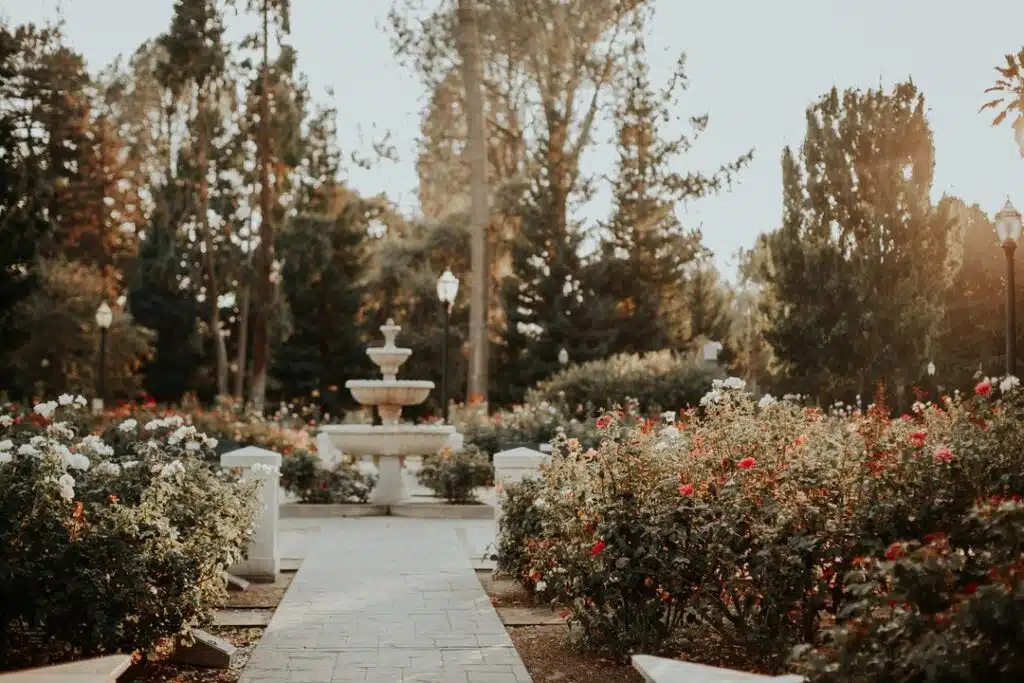Outdoor fountains are perfect for circular driveways, courtyards, entry ways, gardens and patios because the sound of water trickling down them can provide a wonderful sense of tranquility.
Depending on their exact setting, there is an appropriate fountain material that you could implement into your cherished space.
A fountain is something that you will treasure for years to come, so it is important to use the proper material to extend its life span as long as possible.
While the array of fountain materials can be intimidating, we have created a guide that will allow you to choose the material that suits your fountain style best.
Acrylic/Glass/Resin
Glass fountains are gorgeous. They appear more like a work of art than a fountain. However, they are typically not practical for an outdoor setting because they break easily. Acrylic fountains could provide a similar artistic look and a little more durability, but tend to turn a yellowish shade and get brittle over time – the longer it’s left out in the sun year after year. Molded Resin fountains also tend to also get brittle over time, as well as are quite light, so they can blow away in a stiff wind.
Ceramic
When you hear ceramic fountain, think of a large terra cotta pot. These are great because they are relatively small compared to most fountains, and make great patio and deck fountains. Also, they can yield a handmade feel and a sense of tranquility to that smaller space. You can purchase a ceramic fountain or even buy a large piece of pottery and turn it into a fountain yourself for a fun DIY project. If you live in a location that has periodic freezes over the Winter though, make sure you buy a pot small enough to bring it inside for the Winter Season. If you do not do that, after a few short years your ceramic fountain will crack / fall apart, and you’ll have to make a new one.
Cast Stone / Concrete
Cast Stone fountains can be molded into virtually any design, and sometimes can have the appearance of real stone when they are first installed (before the patina coat of color on the surface is worn off or faded.) Cast stone fountains are quite heavy, and weigh almost as much as a real stone fountain. Also, cast stone fountains have particular cleaning needs, right up there with the most delicate and porous of natural stones. And, along with those delicate natural stones, the porous nature of cast or concrete fountains make them imminently unsuitable to be used in a climate that has freeze / thaw seasons throughout the year. If you have your heart set on getting a cast stone or concrete fountain, and live in a climate that freezes periodically…. Keep in mind that the whole fountain MUST covered with a tarp or cover every single Fall (before the Winter freezing temperatures arrive) or your fountain will only last a very few years. (Also, porous fountains need to be shut off and drained several weeks before granite fountains would need to, just to give the porous stone a chance to dry out – even below the surface of the stone.) Otherwise, if you cover a fountain that is actually still wet, you haven’t really protected it from the water freezing inside the stone – and the inevitable damage starting as that same water freezes and starts cracking the stone. (The bad news is, you can’t stop the moisture from coming up UNDERNEATH the fountain…)
Limestone or Marble
Did you know that limestone was used by the Greeks over 4,500 years ago to create statues? It was also used by the Egyptians to build the Great Pyramids. This is because limestone was easily accessible and very quick to carve, as it’s a softer stone. It tends to be a more of a solid color stone, with not a lot of varied colors on each specific block.
Marble fountains tend to have a variety of colors in them, with veins of contrasting color, or sometimes several contrasting colors. They are absolutely gorgeous and they can turn any garden into an outdoor oasis. In fact, they appear more like a work of art than a fountain.
Of course, both Limestone and Marble are more delicate, softer, more porous stones, so that means they need to be maintained with only specific cleaning products – that won’t actually eat away the stone itself while you are cleaning it. Also, they would be more susceptible to damage by hoodlums, as if they really wanted to carve into the stone with something hard, it would be relatively easy to carve their initials into the stone.
And lastly, because of that porous nature, these kinds of fountains will NOT stand up to a freeze/thaw climate indefinitely (the way granite would), even if you cover them each Fall for the whole winter. So, depending on the diameter / height of your fountain, that can make a very unsightly shape in front of your house for 4-6 months of the year during the winter season/holidays.
Travertine or Cantera
These types of stones tend to be unsuccessful as fountains. They are very porous and easy to carve, which tends to mean they are more economical than other types. But both of these kinds of stones tend to have large voids or air pockets in them, which over time can easily create places for the fountain to leak, once the stones break down from chemical attack. And in the instance of Cantera in particular, just from the chemicals you put in the water to keep algae out of the fountain can eat quite a bit of the stone away (in as short as 5-8 years.) And yet again, due to the porous nature of these stones, this kind of fountain would not stand up to a freeze/thaw climate for any more than likely a year or 2, if it’s uncovered during the winter and you get a lot of freeze/thaws that occur during that season. (For example, in some areas, you can get warmer temps during the day – then freeze again at night – so you may have as many as 50-60 times that it freezes and thaws that season…. ) And even if it is covered, they aren’t likely to last more than probably 5-8 years, as over time tarps or covers tend to get holes or sweat on the underside – and those droplets of moisture start the damage process as it infiltrates the stone and freezes over winter.)
Granite
The longevity of granite makes this type of fountain material ideal because it is a highly durable stone and it can be hand carved into virtually any design. Granite comes in many different colors, so you can choose a fountain that perfectly highlights your outdoor getaway. These fountains are not only quite elegant and make for a perfect centerpiece for your estate, but are also the easiest option you could ever imagine in terms of maintenance. Unlike the other softer stones mentioned above, granite is pretty much immune to chemical attack not only from cleaning products, but also the substances you put in the water to keep it clean. So, you can very quickly and easily remove iron stains or calcium scale with various acid solutions, and they won’t affect your stone at all. You just need to make sure you wear skin and eye protection while applying it on a non-windy day, then rinse liberally with water. Check this blog to learn more of the particulars on maintaining fountains. Your fountain pump and lights on the other hand (being made of metal and plastic) are NOT immune to chemical attack though, so make sure you keep that in mind when putting lots of chemicals in your pool.
Basalt
Are you looking for more rustic fountain option, to go in a more informal type area? Basalt fountains convey a lovely sense of tranquility and serenity. The way water accentuates a basalt fountain can make the stone come alive and really stand out in its atmosphere. Typically basalt fountains are installed in a disappearing water feature, which means (since there is no pool of water to accidentally fill with leaves in Fall) this kind of fountain is very well suited to a very wooded area, since the water reserve is actually contained in a pondless basin in the ground under the fountain.
Bronze
Bronze can create a very elegant fountain and its shine provides a classical appearance to any setting. This is a great option if you want to use the soft colors in the bronze to complement the color scheme in your garden. Although, keeping the original colors (for example) on a brown/gold colored bronze fountain is quite labor intensive each year, as the elements tend to always be working on the metal to create a more typical silvery grey / greenish patina. This means every year you’d need to scrub that coloration off the fountain, if you want the original brown / gold colors to remain. Best of all worlds would be if you’d put a 2 coat clear coat on the bronze before you even start the fountain up for the first time – as that will help keep your cleaning down to a minimum. Check out Sculpt Nouveau’s Website, who can explain the various methods to protect your valuable investment. Or, if you like the silvery/greenish color patina on the fountain, just let the process continue until the whole fountain is that same color. (Once that occurs, that means the metal underneath it is now protected – and you can enjoy the fountain for a very long time – with hardly any maintenance at all.)
Bronze is also a great material for your fountain because it allows for smaller details to be incorporated into the design. Your guests will be amazed when they see this work of art in your garden.
What Fountain Material Will You Choose?
Before purchasing your fountain, it is important to evaluate the setting that your fountain will reside. Is it outside in the middle of a circle drive, where it is susceptible to harsh weather? Opt for a durable fountain material such as granite or bronze. Or, if you want a fountain that will be the most easy care in terms of maintenance, a granite fountain will never disappoint you – and it’ll still be around for generations to come!
However, if you reside in a warmer climate (growing season zone 9 or higher) or want to place the fountain inside your home, you could really use any type of fountain you like, and you will have a beautiful piece of art for all of your visitors to admire. (Then you just have to review the different types, and see if the cleaning / chemical restrictions will work with your planned maintenance of the fountain.
Here at Carved Stone, we have fountain materials to fit everyone’s need. Take a look at our wide fountain selection to start your journey to find the perfect fountain for you.

